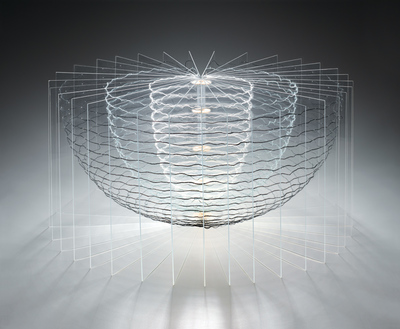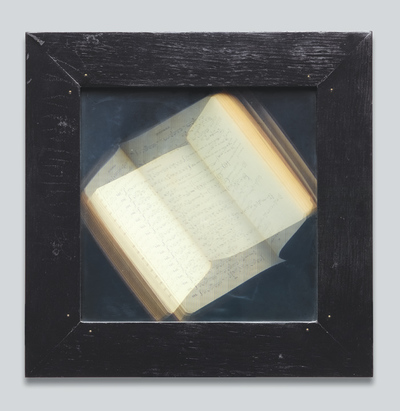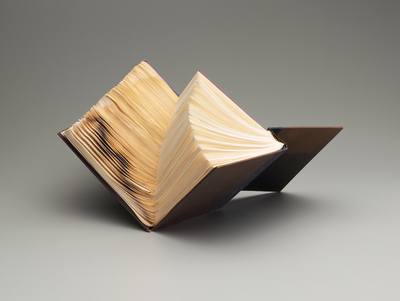Odd and Unbound: Altered Books
Adele Outteridge, Vessels, 2004, Plexiglas with linen thread and binding. © Adele Outteridge.
Once upon a time, a turn of a book page transported us to places familiar, as well as those exotic and unknown. In today’s DIY culture, Martha Stewart Living urges readers to “Transform old magazines into glittered table-top trees….” Just don’t try this with a book or you might be accused of libricide.
On the other hand, consider the noteworthy Yale University Art Gallery’s Odd Volumes: Book Art from the Allan Chasanoff Collection, ensconced on two floors of the Louis Kahn building, where books have been altered in every way imaginable: burned, cut, cooked and even drawn up by a meat hook.
Allan Chasanoff, a 1961 Yale alumnus, spent 20 years carefully collecting some 300 sculptural works, dating from the 1960s, assisted by Brooklyn-based book artist and collections curator Doug Beube. Chasanoff’s book art collection includes works by early makers such as John Latham (The Atom, 1961), Donald Lipski (Integrals, 1997 and U-90-45, 1990) and even Yoko Ono (Everson Museum Catalogue Box, 1971–94).
Six Yale students have gleaned 100 works from this collection (which has been accessioned into Yale’s art gallery) for the Odd Volumes exhibition. Make no mistake, this is no ordinary student-curated show. Students have thoughtfully organized this exhibit with rewarding, didactic exhibit labels and wall text. Works are displayed both as isolated objects and as a survey, adding to the exhibit’s collective experience.
Top: Long-Bin Chen, Punishment #1, 1993, found and cut telephone books, pencils, shelf, and wire. © Long-Bin Chen. Middle: Donald Lipski, Integrals, 1997, found math book with optical lighting film in a wooden box. © Donald Lipski. Bottom: Barbara Berk, Double Exposure, 1997, two found and altered copies of Dick Francis’s Twice Shy. © Barbara Berk. All images from Yale University Art Gallery, The Allan Chasanoff, B.A. 1961, Book Art Collection, curated with Doug Beube.
When entering from Chapel Street, the first piece seen is Long-Bin Chen’s Punishment #1, which floats stoically at eye level. Chen has sculpted telephone books into the shape of a woman reposing on a shelf. However, from the underneath, we see sharpened pencils, mirroring the shape of her body, pointing away from her. No doubt there’s a sociopolitical commentary being made here.
Directly underneath is a leviathan, Cheryl Sorg’s altered book, comprising two copies of Herman Melville’s Moby Dick. Sorg has painstakingly excised and extricated each word of the tome. She has tediously taped the confetti end-to-end starting from the first three words, “Call me Ishmael,” creating a massive vortex. Each ensuing word of the entirety of this encyclopedic, mythic classic can be read in an ever-expanding dizzying concentric spiral. This leaves the viewer to wonder about the work’s title, which seems particularly apt, Surely All This Is Not without Meaning.
On the gallery’s fourth floor, Joe Nicastri’s untitled work (part of a previous installation, According to Plan) is made up of a large cluster of burnt found books, hanging like a smoked ham. The book burning provokes an intellectual response, stemming from cultural, religious or political beliefs. Then there’s a visceral reaction to this corporeal-seeming mass hanging from a meat hook.
All manner of additions and subtractions are employed in manipulating the books. This underscores Allan Chasanoff’s assertion of the book as material, not icon, and the book as a medium, object, subject and sculpture. All of Odd Volumes’ 100 works attest to this, and they manifest many ways of investigation and expression.
Odd Volumes is preeminent in that it firmly establishes the aesthetic of the altered book as an art object. Those engaged in book altering draw their muse from existing books with words, pages and spine. Even though the artist must work with and around these elements, the possibilities, as one can see, are endless.
Concurrent to Yale’s Odd Volumes is Artspace exhibition CT (un) Bound, which also includes book art loaned from the Allan Chasanoff Book Art Collection, but with a twist. This exhibit includes commissioned works by artists who responded earlier this year to an invitation to not only riff off works in the Chasanoff collection, but to consider the significance of place—specifically, Connecticut.
Alison Safford’s inspiration for her installation, Rule of Thumb, comes from her great-grandfather’s Handbooks from the Tool & Die Industry. Once ubiquitous, these handbooks are relics from Connecticut’s brass manufacturing industry, which drew her Lithuanian forbears to the towns of Seymour and Waterbury.
In homage to them and their descendants, and indeed to the artist herself, Safford has bronzed three copies of the handbook and stood them reverently before a wall on which hangs scores of sculpted hands of varying sizes and gestures, copied from old family photographs and cast in porcelain.
Artspace never looked so good.
Andres Azucena Verzosa is an active proponent of New England arts and culture. He is co-editor of the forthcoming Art in Maine: Contemporary Perspectives (University of Maine Press, 2015).




